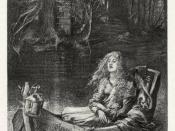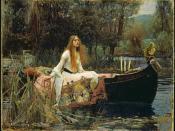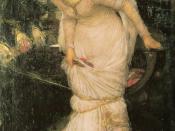The poem "The Lady of Shalott" by Alfred, Lord Tennyson takes it's inspiration from the popular legends of King Arthur. It tells the story of a beautiful woman forced to live in a tower room and weave. The poem poses a hidden question--can the belief in a curse bring about suffering simply because that is the "expected" result?
At first, the Lady finds solace in her weaving. A mirror placed on the far side of her loom allows her to see the front side of her tapestries; it also reflects images from the window behind her. Because she has heard that she will be cursed if she looks directly out the window, the Lady of Shalott can only glimpse the outside world through her mirror, which reflects only shadowy, distorted images. Still, these images give her some look at the rest of the world, and she catches glimpses of marching knights, village girls, wedding couples, funeral processions, and shepherds walking down the road to the nearby town of Camelot.
The first part of this poem presents the reader with a mystery--what curse will come upon the Lady if she does dare to look out the window? She herself does not know, but, fearful of the consequences, she "weaveth steadily" with little concern for the world around her. News of the curse came to her through an anonymous "whisper," but she fears it nonetheless. Though the author does not reveal whether any truth was behind the curse, the reader is led to believe that, if the Lady did not know about it, she would have sat and looked out the window, and perhaps even left her tower altogether. The most apparent theme presented here is that it is better to die early and free than live a long life...


